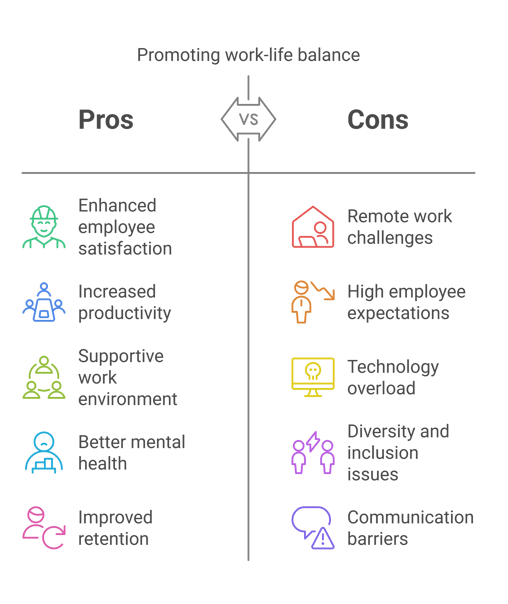Today's HR Challenges for Better Work-Life Balance
In the modern workplace, achieving a harmonious work-life balance has become a critical focus for Human Resources (HR) professionals. This document explores the current challenges faced by HR in promoting work-life balance, the implications of these challenges, and potential strategies for improvement. As organizations strive to enhance employee satisfaction and productivity, understanding these hurdles is essential for creating a supportive work environment.
10/1/20242 min read


Understanding Work-Life Balance
Work-life balance refers to the equilibrium between an individual's professional responsibilities and personal life. It is essential for employee well-being, job satisfaction, and overall productivity. However, achieving this balance is increasingly challenging due to various factors, including technological advancements, remote work trends, and evolving employee expectations.
Current HR Challenges
1. Remote Work Dynamics
The shift to remote work has blurred the lines between personal and professional life. While it offers flexibility, it can also lead to longer working hours and difficulty in disconnecting from work. HR must navigate these dynamics to ensure employees maintain boundaries and avoid burnout.
2. Employee Expectations
Today's workforce, particularly younger generations, places a high value on work-life balance. Employees expect their organizations to support their well-being through flexible schedules, mental health resources, and family-friendly policies. HR faces the challenge of meeting these expectations while aligning them with organizational goals.
3. Mental Health Awareness
The growing awareness of mental health issues has prompted employees to seek workplaces that prioritize their mental well-being. HR must address this challenge by implementing programs that support mental health, such as counseling services, wellness initiatives, and stress management resources.
4. Technology Overload
With the rise of digital communication tools, employees often feel pressured to remain connected outside of regular working hours. HR needs to establish guidelines around technology use to prevent overreach and promote a culture that respects personal time.
5. Diversity and Inclusion
A diverse workforce brings unique perspectives and needs. HR must consider how work-life balance initiatives can be inclusive and cater to the varying demands of different employee groups, including parents, caregivers, and those with different cultural backgrounds.
Strategies for Improvement
1. Flexible Work Arrangements
Implementing flexible work hours and remote work options can help employees manage their time more effectively. HR should encourage teams to create schedules that accommodate personal commitments while maintaining productivity.
2. Clear Communication
Establishing clear communication about expectations regarding availability and workload can help employees set boundaries. HR should promote a culture where employees feel comfortable discussing their needs and challenges.
3. Mental Health Resources
Providing access to mental health resources, such as counseling and stress management workshops, can support employees in maintaining their well-being. HR should regularly assess the effectiveness of these programs and make adjustments as needed.
4. Training and Development
Offering training for managers on how to support their teams in achieving work-life balance can foster a more understanding and accommodating workplace culture. HR should prioritize leadership development in this area.
5. Regular Feedback
Encouraging regular feedback from employees about their work-life balance can help HR identify areas for improvement. Surveys and focus groups can provide valuable insights into employee needs and preferences.
Conclusion
As the landscape of work continues to evolve, HR professionals face significant challenges in promoting work-life balance. By understanding these challenges and implementing effective strategies, organizations can create a supportive environment that enhances employee well-being and productivity. Prioritizing work-life balance is not just a trend; it is a necessity for fostering a healthy and engaged workforce.
